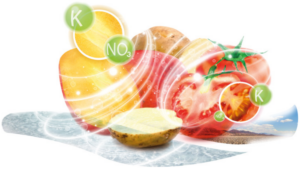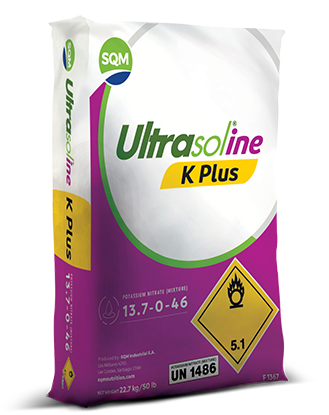“Iodine should be regarded as a plant nutrient”. That is the main conclusion of a scientific paper, published in September 2020 by a group of researchers from Italy. Iodine is recognised as being essential for the health of humans and farm animals, and it has now been discovered that plants require iodine as well, in a micromolar dose in the soil solution. The presence of naturally occurring iodinated proteins in higher plants is now described for the first time and 82 iodinated proteins have been identified. Based on phenotyping, genomics and proteomics studies, it was shown that plants require iodine for leaf and root growth, efficient photosynthesis (the process of converting sunlight into chemical energy in the leaf), timely flowering, increased seed production, and the activation of an early warning system that defends the plant against damage from abiotic and biotic stress. In areas where soil and water are naturally low in iodine, iodine deficiency can result in crop yield loss and reduced fruit quality. In order to provide this element easily and safely, at the correct source, dose and time, there are commercial products that combine iodine and potassium nitrate in a single specialised fertiliser, since the iodine demand of the plant is well timed with typical applications of potassium nitrate as a source of potassium in soil solutions.
Iodine is a mineral nutrient required by plants
The elements that are currently considered to be essential nutrients for plants are C, H, O, N, P, K (primary nutrients), Ca, Mg, S (secondary nutrients), and Fe, Zn, Cu, Mn, B, Cl, Mo, Co and Ni (micronutrients). This list of known plant nutrients can now be expanded with the element iodine, the first new micro-nutrient to be added since Ni in 1987. In Italy, the scientists Pierdomenico Perata, Dr. Claudia Kiferie, her team at the Sant'Anna School of Advanced Studies in Pisa, and scientists affiliated to the National Research Council, have now published this important new discovery: plants bind iodine in 82 different proteins with functions in important biological processes, such as the protein RuBisCO for efficient photosynthesis in leaves, or peroxidase enzymes, which defend the plant from abiotic and biotic stress, and the enzyme ATPase, which is required to supply energy for plant growth and the transport of nutrients. An iodine deficiency in the plant can lead to yield loss, similar to what may occur if the plant is deficient in any other micronutrient. For optimal crop production, an adequate dose of iodine should be applied.
About iodine
Iodine is an element in the periodic table with the symbol I and atomic number 53. Iodine is a halogen, an element classified in the same group as chlorine (Cl) and bromine (Br). Halogens react easily with metals like sodium or potassium. Some examples are sodium chloride (table salt, NaCl) or potassium iodide (KI) which is added to produce iodised table salt for human health.
Where iodine occurs naturally
Iodine is present everywhere, but in only small quantities. The highest amount of iodine is found in the oceans, with an average concentration of 0.5 micromoles of iodine per litre of seawater. In contrast, rain, soil solution and irrigation water contain lower concentrations (less than 0.2 micromoles per litre). In addition, typically, less than 10% of the total iodine in the soil is available for plant uptake. In humans and farm animals, disorders such as goitre and hypothyroidy are caused by a lack of iodine in plants, and alter how the thyroid functions.
Endemic goitre and cretinism in highland and Amazonian jungle regions has been recognised in Peruvian history, due to the permanent natural iodine deficiency in these soils and plants.
Research initiated in the 1960s proves the persistence of severe iodine deficiency and also that this deficiency is a cause of preventable brain damage. A programme to control iodine deficiency disorders for the Peruvian population was created in 1983 and was fully implemented in 1986, with 90% of households reported to have access to iodised salt in 1998.
Plants can absorb and accumulate iodine
It has been known for some time that plants can absorb iodine with their roots and store iodine in their leaves and fruits. The benefit of supplementing small amounts of iodine for plant growth and stress resilience has been observed in many previous studies. Researchers in Italy (the Sant'Anna School of Advanced Studies) have reached the same conclusions after reviewing all the previously-published evidence: plants may accumulate iodine because it is beneficial for plant growth, nitrogen metabolism, resistance to salinity stress in the root solution, and in particular, the production of anti-oxidants by the plant. As with other micronutrients, providing the right dose (not too little, not too much) of the nutrient is very important.
It is also important to provide the right form of iodine. For example, the iodine that is present in disinfectants (free iodine, I2 and iodide I-) may have harmful effects at a lower dose compared to other forms of iodine.
Why plants require iodine
Despite the published benefits of iodine when applied in the right dose, the role of iodine as a nutrient for plants has not received the attention it deserves from the scientific community. Until now. In a paper recently made public, a series of experiments is described. These experiments were carried out by the group of scientists in Pisa, Italy, and demonstrate how iodine is required by plants.
Arabidopsis thaliana was used as the model plant for these experiments. This plant grows quickly in the laboratory (only six weeks from seed to seed) and all knowledge about the genes and metabolism are freely shared on-line by scientists from all over the world.
Plants always contain some iodine as it can be found in small concentrations in air and water. In fact, iodine is added to a known culture medium to study plant physiology in the Arabidopsis. To study the effect of iodine deficiency on Arabidopsis, the water to prepare the soil solution was demineralised by reverse osmosis and ultrapure chemicals were used to make the nutrient solution.
Without the deliberate application of iodine, plant growth and flowering were much slower compared to plants given 0.2 or 10 micromoles of iodine per litre. The application of iodine in micromolar concentrations increased root and shoot growth, seed production and advanced flowering.
To find out why plant growth was compromised in nutrient solutions without iodine, the genetic response of the plant to the presence or absence of iodine in the root solution was investigated. Iodine treatments specifically regulated the expression of several genes involved in photosynthesis, the salicylic acid (SA) stress response pathway, plant hormone response, Ca2+ signalling and plant defence against pathogen attack. The combination of these processes confirms previously published observations that iodine helps plants to prevent damage from biotic or abiotic stress.
In order to test whether the response in plant growth and gene expression was unique to the addition of iodine to an iodine-deficient soil solution, the same experiment was conducted using the halogen that most closely resembles the atomic structure of iodine: bromine. Contrary to iodine, neither the gene expression nor growth of plants responded to the addition of bromine. This proves that the response of the plant to iodine is unique, and cannot be replaced by another element.
Finally, it was discovered that iodine was incorporated into plant proteins, providing the plants with iodine-radiolabelled isotopes recovered in the proteins. These proteins can be enzymes or building blocks of structural complexes that are needed for all cell functions and for collaboration and communication with other cells in and between plant organs.
The iodinated proteins were discovered not only in Arabidopsis, but also in tomato, maize, wheat and lettuce. Finding iodinated proteins in unrelated plant families demonstrates that these iodine-containing proteins occur widely in the plant kingdom.
A total of 82 iodinated proteins were identified for Arabidopsis thaliana using bioinformatic approaches in independent proteomic databases that contain all plant proteins studied world-wide. In the shoots, iodinated proteins are mainly associated with chloroplasts and are functionally involved in photosynthetic processes, whereas those in the roots are mostly various peroxidase enzymes that are important in stress-signalling, or related to peroxidase activity. Some of these proteins are essential for root growth. Iodinated proteins with a crucial function in the nitrogen metabolism, phytohormone regulation and energy production in both root and leaf cells were also found.
These discoveries open a new perspective on new and emerging aspects of plant physiology, especially in the fields of proteomics and enzymology. Iodinated enzymes were found that have pivotal roles in evolutionary conserved basic functions, and this discovery is the first step in generating academic interest in iodine as a major factor in crop production.
Providing sufficient iodine for crops helps prevent yield loss and maintain fruit quality.
Correct iodine supply is of direct benefit to producers in that it improves crop yields and prevents crop losses in areas where there is insufficient iodine available for optimal plant growth. Iodine deficiency for crops in Peru can be predicted from the iodine concentration in water and soil. In well water samples in Ica and Lima, levels between 0.05 and 0.6 micromoles of iodine per litre have been found. It is also known that iodine availability is generally low in the type of soil that predominates in the area (sandy soils, with little organic matter).
In order to facilitate the supply of the correct dose of iodine for farmers and render it safe, iodine can be applied in a better form with potassium nitrate instead of just as a micronutrient. The iodine demand of the plant is well timed with typical applications of potassium nitrate as a source of nitrate and potassium in soil solutions. Potassium nitrate is the optimal source of potassium, as it provides potassium (K) combined with the preferred source of nitrogen: nitrate (N-NO3). The absorption of nitrate nitrogen facilitates the absorption of cations from the soil, such as potassium, calcium and magnesium.
Iodine is the natural complement of nitrate for the transport of calcium in the plant, which will be hindered by iodine deficiency. Iodised proteins in roots are involved in energy metabolism and oxidative stress response, predicting lower calcium transport to fruits with an iodine deficiency. Iodine is also required for the plant to maintain photosynthesis and transpiration in the leaves. In cherry tomato farming in Almeria, Spain, it has been observed that by adequately supplying iodine with potassium nitrate, the improved redox balance and improved energy metabolism facilitated the transport of calcium from the roots to the fruit, resulting in a higher concentration of calcium in the fruit. This is associated with a lower probability of quality issues related to calcium deficiency, such as apical rot, and a longer shelf life during transport. Therefore, ensuring an adequate level of iodine in the soil solution helps producers to achieve optimal crop yields with high quality products, especially under adverse climatic conditions.
For further information on iodine: https://www.worldiodineassociation.com/elemental_chemistry
Prime source:
Kiferle, C., Martinelli, M., Salzano, A.M., Gonzali, S., Beltrami, S., Salvadori, P.A., Hora, K., Holwerda, H.T., Scaloni, A., Perata, P. (2020) Evidences for a nutritional role of iodine in plants. https://doi.org/10.1101/2020.09.16.300079.



